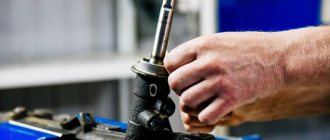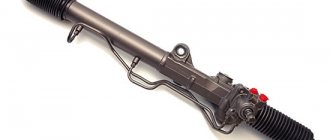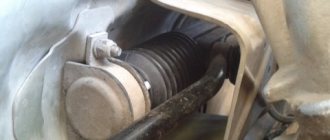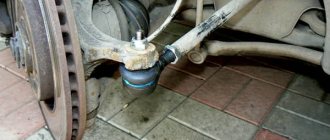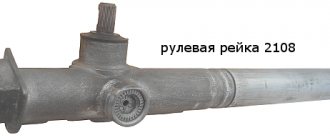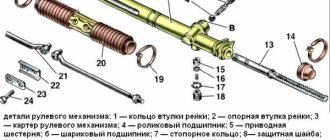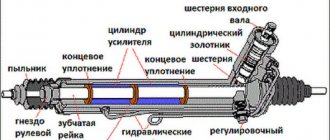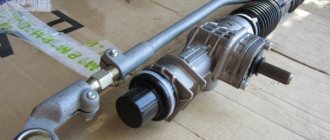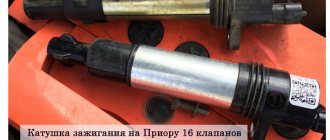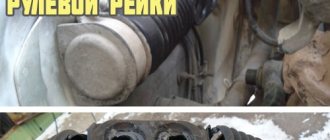About the rake
The steering mechanism on Lada cars, starting with model 2108, has a steering rack. It is designed to move steering rods along a horizontal plane, which helps turn the car's wheels.
The design of the slats is quite simple and reliable, with the exception of one small drawback - a plastic bushing.
This bushing is made by the manufacturer from low-quality plastic, which soon leads to play in the rasp in it and the appearance of an unpleasant knock when moving on paving stones.
There is a rail between the engine and the passenger compartment, perpendicular to the exhaust manifold and attached with two brackets to the engine shield.
Problems with EUR Lada Priora: signs and causes
Previous VAZ models were equipped with power steering, which is less reliable than electric power steering. However, the electric counterpart of this device is also susceptible to malfunctions that need to be identified in a timely manner, otherwise driving safety will be at risk, not to mention comfort. In all cases, when starting to drive, we pay attention to the icon in the form of a steering wheel with an exclamation mark, which flashes on the dashboard every time as soon as we turn the ignition key. If the icon does not go out, then this is a sure sign of a problem with the amplifier.
Design
Steering rack design: 1 – shaft boot, 2 – cover mounting bolts, 3 – Belleville washer, 4 – worm shaft oil seal, 5 – worm gear cover, 6 – sealing collar, 7 – thrust bearing, 8 – worm shaft with bearing, 9 – rasp, 10 – left boot, 11 – binoculars, 12 – binocular bracket, 13 – nut plug, 14 – thrust nut, 15 – thrust spring, 16 – locking collar, 17 – thrust piston collar, 18 – thrust rasp piston, 19 – piston liner, 20 – steering rod bolt, 21 – stopper, 22 – plate, 23 – plastic clamp, 24 – steering rack boot, 25 – left side boot, 26 – steering rack pipe.
Design and circuit of electric power steering Lada Priora
Steering elements of Lada Priora:
1 — right steering rod assembly; 2 — right steering gear support; 3 — steering gear support bracket; 4 — intermediate cardan shaft; 5 — electric amplifier; 6 — steering wheel; 7 — steering column pipe; 8 — left steering gear support; 9 — steering mechanism; 10 — left steering rod assembly
Steering column with electric power steering Priora:
1 - input shaft; 2 - column pipe; 3 — column bracket; 4 — electric amplifier; 5 — electric amplifier control unit; 6 — steering column tilt adjustment lever; 7 — tie rod; 8 — rear bracket for electric amplifier; 9 - spring; 10 — output shaft; 11 — bolt-axle; 12 — front bracket for electric power steering; 13 — power connector of the control unit; 14 — control connector of the control unit; 15 - nut.
Signs of play in slats
When driving over small irregularities such as a gravel road, shocks and knocks in the suspension are clearly audible and are transmitted to the steering wheel. These signs will not always refer to play in the rack. Similar impacts to the steering wheel can occur due to broken steering ends or a broken crosspiece of the steering mechanism. Before you begin repairing the rack, you must exclude the tips and steering cross from suspicion.
- Impacts to the steering wheel when driving over bumps
- Creaking sound when turning the steering wheel
- Biting the steering wheel in different positions
- The steering wheel does not return to zero position
Checking for play
Checking for play is done by rocking the swing arms up and down. To do this, we find the steering rods under the hood and pull each of them up and down; there should be no play or knocking. If any, then the rack should be maintained.
Methods for determining mechanical damage to electric power steering and steering mechanisms
Mechanical damage is checked only when the EUR as a whole is not functioning correctly, but there are no errors on the on-board computer display. To diagnose mechanical breakdowns, turn the steering wheel in different directions until it stops while the engine is running. Of course, the car must be in one place. If you have to exert significantly more force than usual when turning the steering wheel, this indicates a malfunction in the system and a breakdown of one of the components. The same problem may indicate a failure of other components of the steering system.
To more accurately identify problems, a thorough performance check should be carried out. You will need to drive your Lada Priora onto an overpass, pit or lift, and then carefully diagnose all components of the chassis. It is necessary to check the racks, steering rods and other components, since there is a possibility that the amplifier itself is working, and the signs of malfunction are associated with other problems. To service an electric amplifier at home, you will have to completely disassemble the system, clean its components and put it back together.
Pinout diagram and designations of EUR contacts
Lift
If knocking is detected in the steering wheel, it can be tightened, but tightening will be effective only if there is knocking from the worm gear. If the knocking noise comes from a broken plastic bushing, then tightening is useless.
As is known from practice, the worm mechanism is quite reliable and is very rarely the culprit of knocking. Most often the bushing is to blame.
You can determine the culprit of the knock by pulling the steering rods one by one.
- If there is a knocking sound when applying forces to the right link, then the bushing is to blame.
- If there is a knocking sound when you apply force to the left linkage, then the worm gear is to blame.
In the first case, a lift is not advisable. Since the tightening nut only tightens the worm mechanism. To eliminate the knocking noise, it is necessary to remove the steering rack from the car and have it repaired.
EUR failed completely on Priora
In the event of an ESD failure, the on-board computer should (as we would like) display a fault code for the device that led to its shutdown (error codes associated with the ESD begin with the letter “C”). However, in some cases, you can only verify that the ESD is turned off empirically. The easiest way is to try turning the steering wheel with the engine off. Then the engine is turned on and the steering wheel is rotated again. If it feels like the same physical effort is required in both cases, then with a high degree of probability the power steering has turned off. Further movement is only possible to the place of repair. It happens that the EUR and speedometer failure occur simultaneously. A failed speed sensor does not provide a signal to the system, which controls the power steering based on speed indicators. In this case, the problem may lie in damage to the wiring connecting the speedometer, speed sensor and power steering. If everything is fine with it, then the speed sensor should be replaced. In other cases, the reason for turning off the EUR is the following factors that lead to a voltage drop in the vehicle’s electrical systems:
- dirty or burnt contacts, carbon deposits or scale that prevent full electrical conductivity;
- damage to wiring insulation;
- failure in power supply settings;
- low battery charge.
If the amplifier does not have enough voltage, then computer diagnostics will show error C1013. For full operation of the Priora's power steering, it requires a minimum of 13.5 V voltage. Therefore, the initial diagnosis of voltage problems should be carried out as follows:
- measure the voltage on the battery. It may just need to be charged;
- If everything is in order with the battery, then the insulation of the wiring and contacts is checked for short circuits.
An auto electrician can diagnose damage to wires and contacts.
Unstable steering
It happens that while driving on a flat road, the steering wheel suddenly tilts to the side. And this option is much more dangerous than a complete failure of the ESD. In the latter case, the car listens, and you can at least get to the service station, while with unpredictable operation of the amplifier, you can fly off the road or drive into oncoming traffic at any moment. In such cases, it is necessary to completely turn off the amplifier by removing the corresponding fuse (F5) from the interior mounting block. How to get there is worth reading in a separate article. Let’s say right away that the problem may lie far away and not only in the fuse, and in order to understand what is actually causing the EUR to work this way, diagnostics will have to be performed only at a service station, because It is very difficult to do this on your own.
Knock in the steering wheel on a Priora
Most often, knocking occurs due to damage to the mechanical part of the steering system (shaft, steering racks and rods, ball joints, etc.). But on Lada Kalina and Grant cars, the knocking may be associated with play in the gearbox EUR, moreover, produced in Makhachkala. However, if a knock is felt and heard on a Priora, then the reason for its power steering should be looked for last, since VAZ 2170 cars are not equipped with gearboxes, and especially Makhachkala ESDs. This means that you need to pay attention to the mechanical part of the EUR - the shaft, connecting elements, fittings and other parts, but only after checking the other systems. In case of mechanical damage to the EUR, the on-board computer may not show errors at all, which is why it is necessary to dismantle and even disassemble the amplifier.
Repair kit
In a Priora with an EUR, a rack from Kalina was installed with catalog number 11183-3400010 20. Therefore, the repair kit must be purchased specifically from Kalina.
Steering rack number
The repair kit includes a large number of parts necessary for repairs.
The price of a new rack starts from 5,000 rubles and higher, depending on the manufacturer, but new does not mean good, and the cost of a repair kit varies from 500 to 1,000 rubles, which is almost 10 times cheaper than a new rack.
Purpose of the unit
Due to the operation of the ESD, the load and force on the steering wheel are reduced when making a turn. The unit greatly facilitates driving, and at high speed it does not allow dangerous maneuvers.
The unit includes the following components:
- Steering wheel;
- Column;
- Shaft;
- Electric motor;
- Steering mechanism;
- Electronic control unit (ECU);
- Torque sensor.
When turning, the electric power steering is activated. The torque is provided by an electric motor, which is present in the EUR design. The torque sensor measures the indicator and sends it to the ECU. Depending on the angle of rotation, the block calculates how much power needs to be given to the motor. The switch located under the steering wheel contains a device that determines the angle of rotation. The torque and rotation sensors transmit data to the ECU, which “determines” whether the electric motor is running at the desired speed.
Steering rack removal and repair
Removal work must be carried out with the necessary tools. Such as:
- Ratchet;
- Head at “13”, “15”, “17”;
- Key to "14";
- Hexagon at "6";
- Screwdriver "-";
- Hammer;
- The beard is blunt;
- Wrench for tightening the steering rack;
- Steering wheel end remover;
- Mount;
- WD-40 lubricant;
- Lubricant "Litol - 24";
- Steering rack repair kit;
Steering wheel removal process
- We align the steering wheel exactly in the center.
- Raise the left side of the car with a jack
- We unscrew and unscrew the steering end nuts, then use a puller to squeeze them out of the strut bipod.
- We unscrew the steering cardan in the car with a head on “13”, and forget the screwdriver into the slot of the cardan without damaging the splines. This is necessary for its easy removal from the rack splines.
- Remove the steel washer retainer from the tie rod bolts and unscrew the left steering arm from the rack and pull it out into the left window of the tie rods
The process of disassembling the rack
- We unscrew the steering rods with a head at “15”
- We remove the anthers by biting off the plastic clamps with side cutters. We pull out the central steering boot to the right side without damaging it.
- Place a mark as shown in the picture and unscrew the nut securing the rack pipe using a punch and a hammer
- We take out the pipe
- We unscrew the steering tightening nut using a special wrench (don’t be afraid to turn it very tightly), take out the rubber ring and the pressure piston.
- To remove the pressure piston, you need to hit the back of the rack and the piston will fall out.
- We take out the rasp
- We unscrew the two bolts with a hexagon “6” and carefully remove the “worm” cover without damaging the oil seal.
- We clamp the worm shaft into the yew through a block and remove it by hitting the body of the rack
- Next, remove the old plastic sleeve from the pipe using a screwdriver
The rail is disassembled, we proceed to the assembly process using new parts
Assembly
- We install rubber rings on the bushing and insert it into the rack pipe
- We wash the worm shaft from the old grease, lubricate it with new and insert it into place, put a plastic bearing on it.
- Place a disc spring into the worm cover, and then a thrust washer on top. Lubricate well and close the lid.
- We lubricate the rasp and insert it into the worm mechanism, and then insert the pipe into the mechanism body and tighten the nut, aligning the previously placed marks.
Centering the steering rack
When assembling the steering wheel, it is necessary to follow a certain rule, which in the future will not lead to the rearrangement of the steering wheel on the splines.
- When the rasp is placed in the rack body, it is necessary to set it to “zero”, that is, the position in which the steering wheel will stand exactly in the center. To do this, you need to measure 235 mm from the right end of the case and put a mark with a marker. This will be “zero”. Next, you need to align the center of the rasp with this mark. The center of the rasp will be the recess under. We combine this notch with the previously installed mark.
- It should also be noted that when combining these marks, the worm shaft should face the flat to the right side at an angle of 90 degrees to the rack body.
- To combine all these parameters, you need to rotate the worm shaft with a key at “14” until all the parameters are combined.
Attention: the rack pressure piston should not be installed when the marks are aligned.
Self-removal and installation of the amplifier
You can do the procedure for dismantling and installing a new electric amplifier yourself, but for this you will need to prepare all the tools. To complete the job, you will need two screwdrivers - one with a flat head and the other with a Phillips head. You will also need a set of socket wrenches.
How to complete the DIY removal and installation task:
- Before performing work, you will need to turn off the power to the on-board network of your Priora. To do this, turn off the ignition, then open the hood and disconnect the battery from power. After this, you will need to remove the steering wheel, but first remove the plastic trim located under the steering wheel and under the dashboard. The casing is attached to several bolts; they must be unscrewed and set aside. Removing the steering wheel is carried out taking into account the recommendations described in the service manual.
- When the trim is removed along with the steering wheel, you will see the connectors of the steering column switches to which the wires are connected. These plugs will need to be disconnected. The contact ring must also be dismantled.
- Using a 8-mm wrench, you will need to unscrew the bolt that secures the connector with the wires from the ignition switch. Set the bolt aside so you don't lose it.
- Once these steps are completed, press down on the plastic fasteners and disconnect the wiring connectors at the top and bottom of the steering column.
- Having done this, you will see a plastic curtain in the place where the electric amplifier is fixed directly to the speaker. You will need to remove it, which will also require you to remove the fasteners.
- Using a socket wrench, you will need to slightly loosen the nuts that secure the amplifier to the bottom of the speaker. Just loosen it, not twist it. When the nuts are loosened, you need to remove the electric amplifier from its seat; its removal is carried out with the intermediate shaft. But we recommend that you still disconnect the amplifier from the shaft; this will allow you to quickly clean the EUR and simplify the installation procedure. To disconnect the shaft, you will need to unscrew the screw that secures the universal joint to the shaft using a 13mm wrench. Having done this, you will also need to unscrew the two nuts located on the end parts, after which the entire steering column must be removed.
- Then you will need to remove the bolt and cardan from the splined pulley of the mechanism. In this case, pay attention to the labels - during further installation they must match in any case. The marks are located on the protective cover, pulley and starter mechanism cover. Now you can clean the electric booster and other system components or replace the failed EUR with a new one. The assembly procedure is carried out in reverse order.
Photo gallery “Removing the EUR”
EUR and power steering Priora: list of possible faults and repair methods
Hydraulic and electric power steering are designed to ease the effort the driver makes when turning the steering wheel. The EUR is a more advanced mechanism compared to the power steering, since it uses an electric drive. The system does not contain oil or other hydraulic components, which increases its reliability. Typically, AvtoVAZ engineers install electric steering systems on passenger cars, and less often - power steering. Both types of power steering are found on the Lada Priora.
Steering diagram
How to replace electric power steering on a Priora
There are cases that after identifying a malfunction, it is impossible to repair the EUR, and all that remains is to replace it. For such a procedure, it is ideal to go to a workshop, but if this is not possible (for example, field conditions), then you can inspect the Priora with your own hands, not only check the condition of the contacts yourself, but also remove them, after which repair the EUR (the connection diagram is similar ).
- First of all, free its control unit by removing the steering wheel with the airbag, the casing and the ignition switch.
- Take the head “8” and remove the contact group from the shaft.
- Disconnect all wiring from the gray EUR Priora control unit (attention, the wire plugs have separate locks, try not to damage them when removing them!).
- Find the steering rack and cardan mount, unscrew the bolt and disconnect them.
- Using a hammer and chisel, loosen the cardan coupling, then unscrew the fastenings on the amplifier (four nuts).
- Carefully remove the unit along the guide.
To connect the power steering, follow the same procedure, only in reverse order.
The design and principle of operation of the Priora steering mechanism
On front-wheel drive vehicles, due to their design features, it is impossible to install a classic steering mechanism. The first thing engineers encounter is lack of space. A standard mechanism cannot be installed, even if a transverse engine is used instead of an in-line engine. For this reason, the classics, which are not distinguished by modest dimensions, have been replaced by a compact steering rack, which transmits the force when turning the steering wheel to the front wheels.
To save as much space as possible, on Priora and many other cars the rack is rigidly fixed to the front panel of the engine compartment - between the engine and the passenger compartment. It connects to the steering column, which extends into the cabin and ends with the steering wheel. The steering rack is a toothed metal rod. Its teeth engage with the steering wheel drive in the form of a shaft. They are located relative to each other at right angles. This is an improved worm drive.
The driver rotates the steering wheel along with a shaft, the teeth of which move the steering rack inside the casing, engaging with a toothed rod. There are holes in the rack casing through which the steering ends (rods) are connected. In the center of the rack itself there are holes for attaching these tips, which are attached to the steering knuckles of the front wheel strut using rods and special levers.
Frequent electric power steering malfunctions and repairs
A good scan tool, service information, TSB and how to update calibrations are important to successful vehicle repairs. Problems with the EPS system usually boil down to one of three causes: mechanical, electrical, or hidden problems that make you think they are steering related when in fact they are caused by another system or component. And it's relatively easy to figure out which of the three is causing the problem.
Mechanical problems
Mechanical EPS problems manifest themselves as noise, vibration, or other physical problems with the steering system. They range from mildly annoying to downright frightening, so it's important to determine the cause as quickly as possible.
If the problem is mechanical, repairing the Prior's electric power steering is very similar to diagnosing the hydraulic system. You should separate the auxiliary part of the system from the actual mechanical components and see if the problem changes or goes away. To do this, remove the road load from the steering components and see if the noise goes away. There will still be mechanical problems.
However, remember that slight noise (humming or low whine) is normal operating characteristic.
If the problem is in the steering column assembly and the module, motor, or both are replaced, repairing the Priora electric power steering will require a diagnostic tool, a torque sensor and its calibration, as well as correct system settings. Also note that steering wheel position and torque sensor calibration procedures must be performed after adjustment. Complaints of poor or uneven "feel" of the center or return to the center can also be corrected by following these procedures.
Electrical faults
If the electric power steering on a Priora does not work, problems can manifest themselves not only in the form of fault codes and warning messages. These can cause the steering to be difficult to function or not work at all (for example, if the steering column is overheated due to excessive lock-to-lock rotation, this does set a trouble code).
If there are problems repairing the Euro Priora, it is best to start with the basics. The simplest check is battery voltage. If there is not enough power supplied to the system, it will not be possible to provide sufficient power steering. Check the battery voltage signal on the scan tool, and also check the voltage at the 12-volt battery itself.
And accordingly, include the 60 amp EPS fuse in the preliminary diagnostic test, especially if the vehicle has been towed and there are no DTCs stored. On some vehicles, the electric power steering fuse may blow.
However, most problems with electrical systems set and store codes (DTCs), so Priora electric power steering repair recommends checking them, current and historical, in the early stages of diagnosis. If trouble codes are stored in memory, carefully check the connections, especially between the EPS engine and PSCM, making sure that the connector is not just connected, but actually installed, and does not disconnect on its own. And check that the connector contacts are secure, especially if they have been disconnected several times.
Connections and wiring is a good place to check communication history codes (U-codes). U codes are difficult to diagnose because they may be the result of communication problems from other modules rather than the module storing the code. TSBs can be a real helper for U-codes.
Also be sure to check calibration updates for EPS issues. Sometimes the only way to fix a problem is to reprogram the module, so it's best to find out in advance.
However, if the EUR does not work on the Prior, and your diagnosis points to the control module, keep in mind that the PSCM may require adjustment of transmission data, body type, tires and wheel size, and the torque sensor may need to be additionally calibrated before the vehicle will operate correctly .
One final note about diagnosing electrical EPS: If you need to disconnect the 12-volt battery, wait at least 25 seconds after turning the ignition off before doing so to prevent loss of module memory. This advice can be applied to all systems, not just EPS.
Hidden problems
Steering and front suspension noise problems - clunking, knocking, rattling, crackling, shaking, vibration - include:
- the bumper contacts the upper spring seat (on Cobalt and HHR);
- contamination of the ball pin of the stabilizer rod;
- PCM and TCM were arguing with each other;
- The coolant expansion tank is not installed correctly;
- contact between the front stabilizer shaft and its bushings;
- The rear lower arm is in contact with the body because the rubber bushing comes out of the steel bushing, especially in areas where road salt is used in the winter.
It's easy to think that if the electric power steering on a Prior isn't working, then any problem with the EPS system (or any other electrical system for that matter) will be caused by a complex and expensive component, but this is often not the case at all.
Suspension and component noises on cars with EPS can be localized in the same way as on cars without: look for contact marks on bushings (also those that are missing or damaged), worn, broken, damaged or missing parts and any recent body work or recent replaced components.
Design and operating features of power steering and power steering
To make steering easier to turn and increase comfort, either hydraulic or electric power steering can be used. Both amplifiers have both pros and cons.
Power steering device
Structurally, power steering is a system of high and low pressure hoses containing oil driven by a pump. Power steering fluid must be poured into the reservoir near the pump. It only works when the engine is running. The driver turns the steering wheel, and at this time the fluid flows through the distributor under pressure created by the pump to the steering mechanism. It enters the working cylinder, puts pressure on the piston, which begins to move, and facilitates the rotation of the steering wheel. When moving in a straight line, the liquid flows back into the system reservoir.
Advantages and disadvantages of power steering
In the case of a hydraulic booster, the main disadvantage is the bulkiness of the entire system. But it is cheaper to produce and maintain, and this affects the price of the car. At the moment, power steering is found mainly on budget class cars, which include Priora. An amplifier of this type is also installed on expensive, powerful SUVs. This is explained by the fact that the power steering is capable of transmitting greater torque transmission power to the steering. In this regard, it outperforms an electric booster, but there are still more disadvantages:
- In a car equipped with a hydraulic booster, it is not recommended to hold the steering wheel in the extreme right or left position for more than 5 seconds. Otherwise, the oil in the power steering on the Priora begins to heat up, which can lead to system failure.
- The mechanism requires constant monitoring of the oil level, inspection and replacement of drives, hoses, and pump.
- The pump depends on the operation of the engine, which means it takes a certain percentage of power from the power plant. If the power steering does not work when driving in a straight line, this percentage of power is wasted.
- Such a system does not imply setting operating modes depending on the speed of movement or the angle of rotation of the steering wheel.
- At low speeds, the steering mechanism provides good sensitivity, but at high speeds it becomes less pronounced.
Engineers compensate for the last drawback by using a steering rack with a variable gear ratio. Power steering has already become an outdated system; designers are no longer involved in improving it.
Electric amplifier design
The design of the EUR is simpler than that of the power steering. It consists of an ECU, a torque sensor, a steering angle sensor and an electric motor. There are no hoses or fluids here. The electric motor is mounted directly on the steering rack itself, and torque is transmitted to it via a torsion shaft built into the steering mechanism system.
In the case of power steering, the force is facilitated by liquid, and in the electric booster the current is responsible for this. When the driver turns the steering wheel, force is transmitted to the steering rack. At this time, the torque sensor transmits data to the electronic control unit. The controller calculates how much current needs to be sent to the electric motor to optimally facilitate steering rotation. Since the force must be uniform, the speed of movement and the angle of rotation of the steering wheel are taken into account.
If the steering wheel rotates without the vehicle moving or at low speed, as when parking, the electric motor receives maximum current and the steering wheel turns easily. When driving at medium and high speeds, such force is no longer required, and the controller supplies a lower current.
Pros and cons of EUR
The electric booster is a more modern system with high potential for modernization. It is not without its shortcomings, but there are fewer of them than the power steering:
- high price,
- The electric motor cannot provide high power, so it is installed only on passenger cars.
The disadvantages are leveled out, since the design of the electric amplifier is constantly being improved.
The EUR for the Priora has many advantages. The system is easy to maintain due to its simple design. The only part that requires inspection is the rolling bearing. The ESD mechanism has more compact dimensions and can be installed on the steering shaft in the cabin, freeing up space in the engine compartment. Due to this, the durability of the structure increases, since there is no exposure to temperature changes and high humidity.
The electric booster does not take power away from the engine, which saves fuel. The drive only operates when the steering wheel is turned. The ECU is responsible for the operation of the amplifier, with the help of which you can adjust the operating mode of the EUR, taking into account the operating conditions of the vehicle. The electric booster is not afraid of extreme steering positions. Driving at high speed makes the steering wheel with ESD more sensitive.
Complete failure of the electric amplifier
Despite the fact that the ESD is considered more reliable than the power steering, it still has malfunctions, and since this directly affects safety, repairs should be made immediately.
There are not so many malfunctions that arise with the EUR on the Priora. The first thing that happens is the amplifier stops working completely. Often, turning off the amplifier is accompanied by a corresponding code, which is displayed on the display of the on-board computer, although there are also cases when its shutdown can only be detected experimentally.
Power steering for modern Lada
To do this you need to do:
- Several turns of the steering wheel in different directions with the engine not running.
- Then you need to carry out the same operation, but with the car running.
- If the force required to apply to the steering wheel has not changed, this means that the power steering is not working.
The movement, of course, can be continued even if the amplifier is not working, but it is not advisable; it needs to be repaired as quickly as possible and restored to functionality.
There are times when the amplifier on a Priora turns off along with the speedometer. The culprit is the speed sensor. The fact is that these three elements are interconnected. This scheme allows you to regulate the operation of the electric power steering depending on the speed limit. Repair in this case comes down to checking the functionality of the speed sensor and the wiring going to it, the speedometer and the power steering. If commutation breaks are detected, it must be restored. And when the fault is in the sensor itself, it is simply replaced.
The electric booster may turn off due to low voltage in the on-board network of the Lada Priora. This indicates that the insulation in the wiring may be damaged, causing a short circuit or problems with the generator's performance so it is not producing the correct voltage. The repair consists of checking and restoring the integrity of the wiring, as well as checking and troubleshooting the generator.
Severe contamination of the contact group of the torque sensor installed on the amplifier can also cause a shutdown. Moreover, the on-board computer, conducting self-diagnosis of the system and identifying problems with the operation of the torque sensor due to contamination, can itself deliberately turn off the amplifier. Repair in this case comes down to removing the EUR from the car, disassembling and thoroughly cleaning the contact group. But since the operations to restore the functionality of the electric booster are complex and incorrect assembly and installation of it on the car can affect the correct operation of the steering mechanism, it is advisable to contact specialists to restore the power steering.
But as already mentioned, completely disabling the electric power steering only leads to the need to make more effort when driving, and such a malfunction does not significantly affect safety while driving.
Priora steering rack malfunctions
Problems with the functioning of the steering rack can be different. To identify them, it is not necessary to have a wealth of special knowledge; it is enough to periodically inspect the mechanism.
Large steering play
If you turn off the engine and actively turn the steering wheel, there should be no extraneous sounds. When not only suspicious noises appear, but also play is observed, the cause of the problem may be a weakened spool stop or insufficient elasticity of the torsion bar. The steering wheel may play due to severe wear of the silent blocks on which the steering rack is fixed. The same problem occurs when the angle of contact between the teeth and the screw is incorrect, or the curvature of the crankcase or shaft is caused by damage or the stroke of a screw-type bearing. To determine the malfunction, you will need to diagnose the rack bushing, steering rod joints and teeth.
The appearance of knocking and heaviness when turning the steering wheel
The steering wheel becomes heavy due to a soured cardan, but most often it is the knocking that occurs. There are a number of characteristic reasons for this phenomenon:
- noise occurs during the movement of the vertical bearing shaft;
- excessive wear of joints and crankcase;
- exhaustion of the life of a screw bearing, bushing or teeth;
- crooked shaft or crankcase, as a result the screw contacts the teeth with an offset angle;
- wear of silent blocks;
- loose rack fastening;
- steering wheel play.
In any case, you will need to carry out diagnostics, and if malfunctions are identified, you will need to dismantle and repair the Priora steering rack with replacement of worn elements.
Worn steering shaft center tooth
Wear of the mechanism with teeth occurs quite often. The main purpose of the steering shaft is to convert rotational motion into translational motion. Most cars are characterized by the exhaustion of the resource of the central teeth. The reason is simple: movement in city traffic is determined by driving in a straight line with slight deviations of the trajectory to the left or right.
To determine the malfunction, you need to swing the steering wheel to the sides from the middle position. If knocking noises are heard, it is better to carry out further diagnostics at a service station. If the central tooth is worn excessively, the entire shaft must be replaced.
Mechanical failures of the EUR
Why, exactly, did we remove the EUR? Diagnostics of the electrical part of the device did not reveal any problems, which means that we need to look for the cause of its malfunctions in the mechanics, which may be as follows:
- Worn or clogged drive elements or worm gear;
- Wear of the support bearing of the worm shaft of the electric drive;
- Other signs indicating destruction or wear of ESD parts.
In such cases, it is necessary to replace the worn part, if possible, trying to understand the factors that influenced this result of the amplifier's operation, or, in critical cases, buy a new electric amplifier.
How to keep the EUR in working condition longer?
Despite the fact that you can remove the EUR yourself in a garage, without special tools and special skills, this procedure is not quick, because There is no way to quickly get to this device. Therefore, motorists are interested in a simple question - how to avoid the need to repair or change the EUR. The answer is obvious - you need to extend its service life. To do this you will have to adhere to the following rules:
- Never move away if the steering wheel is in one and the extreme positions. It is also not recommended to leave the steering wheel in this position for a long time, even without moving;
- Do not hold the steering wheel for more than 4-5 seconds in extreme positions, even if parking or turning requires it. It is better to make the necessary maneuvers;
- Pay attention to sounds coming from the electric amplifier;
- Clean contacts and moving mechanisms from dirt;
- Pay attention to the condition of the wiring and terminals if they come into view when checking other technical systems;
- Carry out diagnostics of this node more often.
Problems in the operation of the hydraulic booster
All breakdowns of the Priora power steering, as well as the causes and methods of eliminating them, are listed in the table:
Malfunction
Remedy
| When turning the steering wheel, you feel a kickback (shocks in the opposite direction) | Worn or loose pump drive belt | Replacing or adjusting belt tension |
| It takes a lot of effort to turn the steering wheel. | The pump belt is worn or loose. Low fluid level in the reservoir. The fluid reservoir filter is clogged. Low pump pressure or air lock in the system. Insufficient engine idle speed. | Adjust or replace the drive belt. Add liquid to the reservoir. Replace or clean the filter. Replace the pump. Remove the air lock. Adjust idle speed. |
| More effort is required to rotate the steering wheel in the middle position | Pump or steering mechanism faulty | Check, repair or replace the pump. Find and fix the steering mechanism problem |
| More effort is required to turn the steering wheel to one side | The pump has failed | Pump repair or replacement |
| Steering is unclear | There is not enough fluid in the reservoir or it is leaking. Air in the power steering system. Resource development. | Add fluid and fix leaks if any. Remove the air lock. Check steering components and replace if necessary. Replace tires. |
| It takes a lot of physical effort to quickly turn the steering wheel | The belt tension has weakened. Air in the system. The pump is faulty. Failure of parts of the steering mechanism. Floating idle speed. | Pull the belt. Remove the air lock. Replace the pump if it cannot be repaired. Check and eliminate faulty parts of the steering mechanism. Adjust idle speed. |
| Noise during power steering operation | There is not enough liquid in the tank. The liquid is discharged through the safety valve (a whistle is heard when the steering wheel is turned to the extreme position). | Add fluid and fix the leak. Remove the air lock. Check the pump pressure, repair or replace the part. |
| Steering wheel vibration | Airlock. The wheels are out of balance or the tires are damaged. | Remove air. Balance wheels or replace tires |
Advantages and disadvantages of amplifiers
| Power steering | Electric power steering |
| Full transmission of the influence of the road surface from the wheels to the steering wheel, which provides good feedback. | Easier to operate and repair. |
| It absorbs part of the engine power, which is why you have to constantly monitor the fluid level in the power steering reservoir and the condition of the pipelines. | Less impact on power. |
| The transfer of influence from the wheels occurs to a much lesser extent, so there is less feedback, which affects the so-called “road feel”. The absence of this feeling, especially in winter, can lead to an incorrect assessment of the situation while driving. |
Lada Priora can be equipped with both a hydraulic booster and an electric booster. Many car enthusiasts increasingly prefer cars with EPS, although it would be more accurate to call it EMUR - electromechanical power steering.
The process of removing the electric amplifier
In order to work directly on the EUR, you will need 8 and 13 mm sockets, a ratchet or a wrench. Next we proceed as follows:
- Using an 8mm socket and ratchet, unscrew the terminal block and remove it from the shaft;
- We disconnect all the wires leading to the EUR control unit, paying attention to the principle of operation of the wire clamps. If you do not deal with it, the clamps can be damaged so much that you will need to replace this wiring element;
- We find the universal joint of the electric power steering and the head of the coupling bolt on it. Unscrew the bolt with a 13mm head;
- Using a hammer and chisel, slightly expand the coupling clamp of the universal joint;
- Unscrew the 2 upper nuts that secure the power steering to the body;
- The 2 lower nuts do not need to be unscrewed completely; it is enough to turn them 4 turns while holding the EUR;
- After everything, the EUR can finally be removed from the body by pulling the steering rack off the shaft.
Now we have the opportunity to completely disassemble the amplifier, perform visual diagnostics for breakdowns, clean it and put it back. Installation of a repaired or new electric power steering occurs in the reverse order. Before doing this, it is important to check the correct location of the special marks on the protective cover, shaft and crankcase cover. Of course, simply removing the EUR does not always make it possible to find the cause of its malfunction, since it may lie in the electrical part of this unit. In the latter case, you will need subtle diagnostics at a service station, which an ordinary motorist is unlikely to be able to perform in a garage environment.
How to tighten the steering rack on a Priora: tips and instructions, nuances with ESD and power steering, videos on the work
Lada Priora is a Russian-made car that is highly popular among our compatriots due to its low price and attractive appearance. However, even despite this, the Lada Priora has one vulnerability associated with the poor quality of the road surface - the steering rack or, in the language of specialists, the “power steering/power steering gearbox”. Fortunately, you can tighten it with your own hands.


